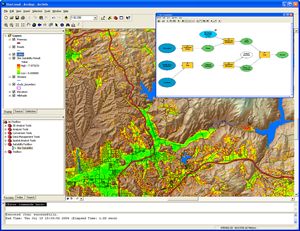 |
| |

Use ModelBuilder and the geoprocessing framework in ArcGIS 9 for suitability modeling. |
ArcGIS 9 is a framework of integrated GIS software products for building a complete GIS that is right for any organization. The fundamental architecture of ArcGIS enables users to deploy GIS functionality and business logic wherever it is needed in desktops, on servers, over the Web, or in the field. This architecture, coupled with the geodatabase, forms a comprehensive infrastructure for assembling intelligent geographic information systems.
ArcGIS 9 focuses on the following key areas:
- Geoprocessing—ArcGIS 9 Desktop (ArcView, ArcEditor, and ArcInfo) includes a completely new environment for geographic data processing and analysis (geoprocessing). The new geoprocessing framework includes ModelBuilder, an interactive and visual application for creating and executing process models; a sophisticated scripting environment; and an intelligent command line interface. The combination of powerful tools and flexible working environments enables users to select the technology that best supports their natural work flows and application requirements.
- Global and 3D Visualization—The ArcGIS 9 3D Analyst extension introduces ArcGlobe, a revolutionary new technology for viewing geographic data seamlessly from a whole earth, 3D perspective. Any ArcGIS supported data, including images, textures, terrain, and 3D objects such as buildings and trees, can be visualized intuitively by layering the information on a three-dimensional globe. ArcGlobe takes the powerful visualization capability of a map to a whole new perspective. More than 500 realistic 3D symbols, objects, and textures are included in addition to tools that can create or import 3D objects from other authoring software products (see Real Symbols for ArcGIS 3D Analyst).
- Interoperability—Esri continues to focus on providing technologies that enable organizations to easily share information across applications and industries, regardless of data format, schema, or database management. ArcGIS 9 expands the support for true interoperability with two new extensions, ArcGIS Data Interoperability and ArcIMS Data Delivery (see Esri Expands Support for Data Interoperability and Standards). These new extensions eliminate barriers for data sharing by providing state-of-the-art direct data access, data transformation, and export capabilities.
- Cartography—The key to intelligent cartography is better annotation and labeling. Significant improvements in the user experience for creating, editing, and managing labels and annotation are incorporated into the core ArcGIS 9 Desktop products. In addition, ArcGIS 9 provides advanced capabilities for high-quality cartographic text placement, labeling, and conflict resolution via Maplex for ArcGIS, a new desktop extension that significantly reduces map production time and enhances cartographic quality.
- GIS Infrastructure—ArcGIS 9 is built on information technology standards, such as component object model (COM), .NET, Java, XML, and Simple Object Access Protocol (SOAP), to facilitate the creation of a geospatial infrastructure within any organization. Two new products are introduced: ArcGIS Engine (see ArcGIS Engine Now Shipping: Create Focused GIS Applications) for embedding GIS functionality into desktop and field applications, and ArcGIS Server (see ArcGIS Server Now Shipping: Comprehensive, Server-Based GIS), a centrally managed framework for serving enterprise GIS applications.
The ArcGIS 9 family of products includes ArcGIS Desktop (ArcReader, ArcView, ArcEditor, ArcInfo, and ArcGIS extensions), ArcSDE, ArcIMS, ArcGIS Engine, and ArcGIS Server. For more information, visit www.esri.com/arcgis. Outside the United States, contact your local Esri distributor; see www.esri.com/international for a current distributor list.
|